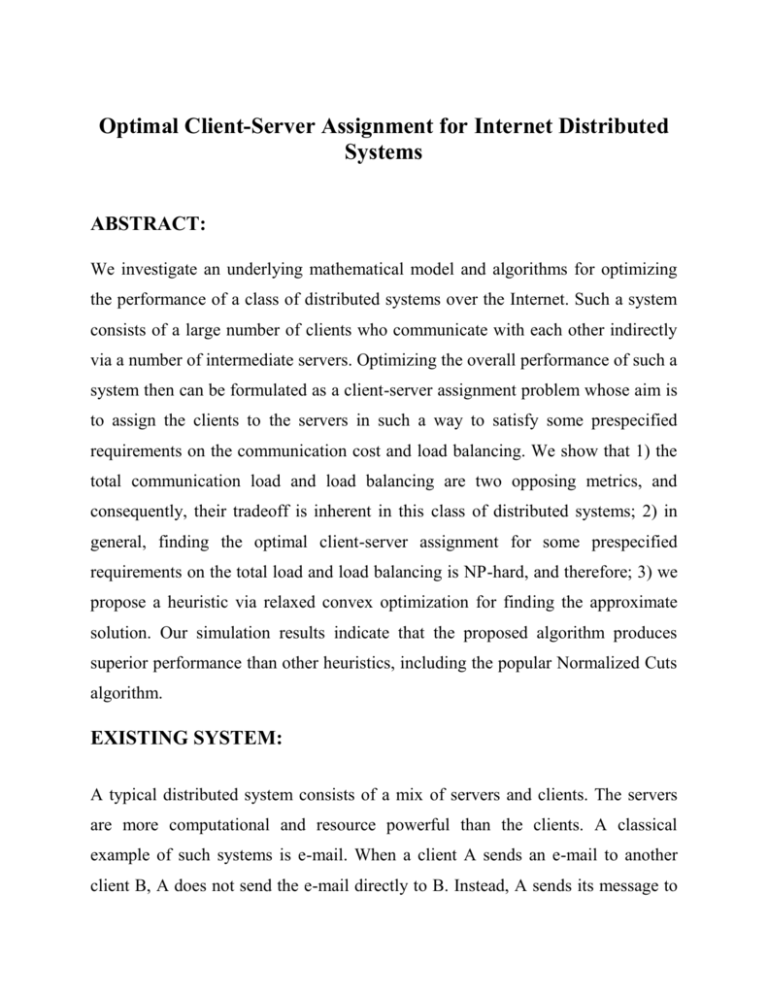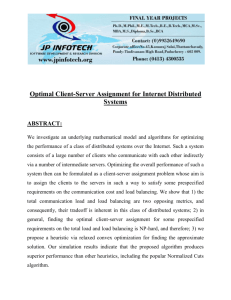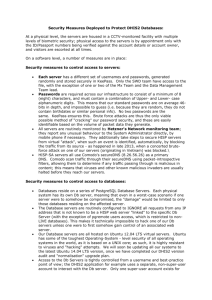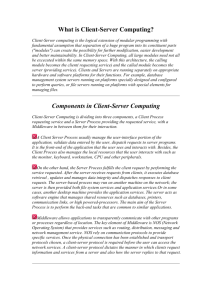Optimal Client-Server Assignment for Internet Distributed Systems
advertisement

Optimal Client-Server Assignment for Internet Distributed Systems ABSTRACT: We investigate an underlying mathematical model and algorithms for optimizing the performance of a class of distributed systems over the Internet. Such a system consists of a large number of clients who communicate with each other indirectly via a number of intermediate servers. Optimizing the overall performance of such a system then can be formulated as a client-server assignment problem whose aim is to assign the clients to the servers in such a way to satisfy some prespecified requirements on the communication cost and load balancing. We show that 1) the total communication load and load balancing are two opposing metrics, and consequently, their tradeoff is inherent in this class of distributed systems; 2) in general, finding the optimal client-server assignment for some prespecified requirements on the total load and load balancing is NP-hard, and therefore; 3) we propose a heuristic via relaxed convex optimization for finding the approximate solution. Our simulation results indicate that the proposed algorithm produces superior performance than other heuristics, including the popular Normalized Cuts algorithm. EXISTING SYSTEM: A typical distributed system consists of a mix of servers and clients. The servers are more computational and resource powerful than the clients. A classical example of such systems is e-mail. When a client A sends an e-mail to another client B, A does not send the e-mail directly to B. Instead, A sends its message to its e-mail server which has been previously assigned to handle all the e-mails to and from A. This server relays A’s e-mail to another server which has been previously assigned to handle e-mails for B. B then reads A’s e-mail by downloading the e-mail from its server. Importantly, the e-mail servers communicate with each other on behalf of their clients. The main advantage of this architecture is specialization, in the sense that the powerful dedicated e-mail servers release their clients from the responsibility associated with many tasks including processing and storing e-mails, and thus making e-mail applications more scalable. A more interesting scenario is the Instant Messaging System (IMS). An IMS allows real time text-based communication between two or more participants over the Internet. Each IMS client is associated with an IMS server which handles all the instant messages for its clients. Similar to e-mail servers, IMS servers relay instant messages to each other on behalf on their clients. In an IMS that uses the XMPP (Jabber) protocol such as Google Talk, clients can be assigned to servers independent of their organizations. DISADVANTAGES OF EXISTING SYSTEM: We use multiple servers; we also need to balance the communication load among the servers for the following reasons: If one server is overloaded, we need to add another server to distribute the load, which is economically inefficient and usually increases the overall communication load As a heavily loaded server typically exhibits a low performance, we would like to avoid the situation. To minimize the amount of total communication load, assigning all clients to one server is optimal. However, it is impossible due to overloading and completely loses the load balance. Simple load balancing does not usually take account of reducing the overall communication load. PROPOSED SYSTEM: In the proposed system the primary contribution is a heuristic algorithm via relaxed convex optimization that takes a given communication pattern among the clients as an input, and produces an approximately optimal client-server assignment for a prespecified tradeoff between load balance and communication cost. we must strike a balance between reducing the overall communication load and increasing the load fairness among the servers, i.e., the load balance. ADVANTAGES OF PROPOSED SYSTEM: The advantages of the proposed system have follows: The two groups have different number of servers, a server within a group with fewer servers will likely to have a higher load than a server in the group with more servers. This reduces the load balance. We describe a number of emerging applications that have the potential to benefit from the client-server assignment problem. SYSTEM ARCHITECTURE: ALGORITHMS USED: SYSTEM CONFIGURATION:HARDWARE CONFIGURATION: Processor Speed - Pentium –IV 1.1 Ghz RAM - 256 MB(min) Hard Disk - 20 GB Key Board - Standard Windows Keyboard Mouse - Two or Three Button Mouse Monitor - SVGA SOFTWARE CONFIGURATION:- Operating System : Windows XP Programming Language : JAVA Java Version : JDK 1.6 & above.








